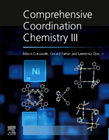
Comprehensive Coordination Chemistry III: From Biology to Nanotechnology
Constable, Edwin
Parkin, Gerard
Que, Lawrence
Comprehensive Coordination Chemistry III describes the fundamentals of metal-ligand interactions, provides an overview of the systematic chemistry of this class of compounds and details their importance in life processes, medicine, industry and materials science. The metal-ligand interaction is the link between the award of the 1913 Nobel Prize in Chemistry to Alfred Werner, the father of Coordination Chemistry, the 1987 prize for supramolecular chemistry and the 2016 award for molecular machines. The key role of coordination chemistry in the assembly of hierarchical nano- and micro-dimensioned structures lies at the core of these applications and so this MRW bridges several sub-disciplines of chemistry, targeting a truly interdisciplinary audience. This third edition is not just an update of the second edition, it includes a significant amount of brand new content. In the descriptive sections 3-6, the emphasis is upon material that has appeared in the primary and secondary review literature since the previous edition published in 2003 to ensure completeness. The material in the other sections is newly written and the emphasis is upon modern aspects of coordination chemistry and the latest developments in the field. Organometallic compounds were defined and covered in the previous two editions and so will not be a focus in this work. The go-to foundational resource covering all of coordination chemistry research and providing insights into future directions of the fieldWritten and edited by renowned academics and practitioners from various fields and regions this authoritative and interdisciplinary work is of interest to a large audience including coordination, supramolecular and molecular chemistsContent is clearly structured, organized and cross-referenced to allow students, researchers and professionals to find relevant information quickly and easily INDICE: Section 1: Fundamentals: Ligands, Complexes, Synthesis and Structure a. Historical Overview b. Ligands c. Synthesis and Characterization of Coordination Compounds d. Reactions of Coordinated Ligands e. Stereochemistry, Structure, and Crystal Engineering f. New Synthetic Methods g. Nomenclature Section 2: Fundamentals: Characterization Methods, Theoretical Analysis, and Case Studies Section 3: Main Group, Lanthanoid and Actinoid Metals a. Group 1 b. Group 2 c. Section 3: Group 12 d. Section 4: Group 13 e. Section 5: Group 14 f. Section 6: Group 15 g. Section 7: Lanthanoids h. Section 8: Actinoids Section 4: Transition Metal Groups 3-6 Section 5: Transition Metal Groups 7 and 8 Section 6: Transition Metal Groups 9-11 Section 7: From the Molecular to the Nanoscale: Synthesis, Structure, and Properties Section 8: Bio-coordination Chemistry Section 9: Applications of Coordination Chemistry
- ISBN: 978-0-08-102688-5
- Editorial: Elsevier
- Encuadernacion: Cartoné
- Páginas: 6000
- Fecha Publicación: 15/07/2021
- Nº Volúmenes: 1
- Idioma: Inglés
